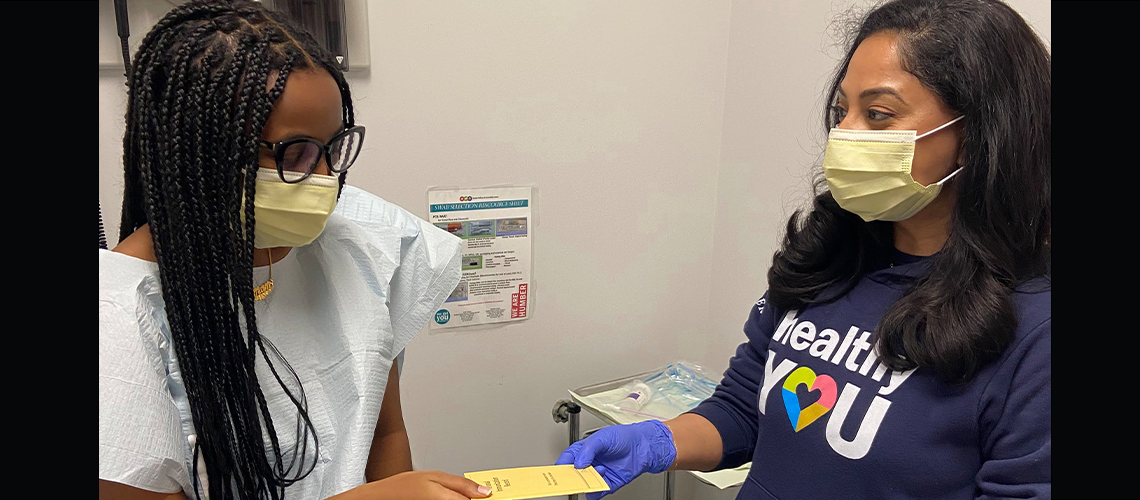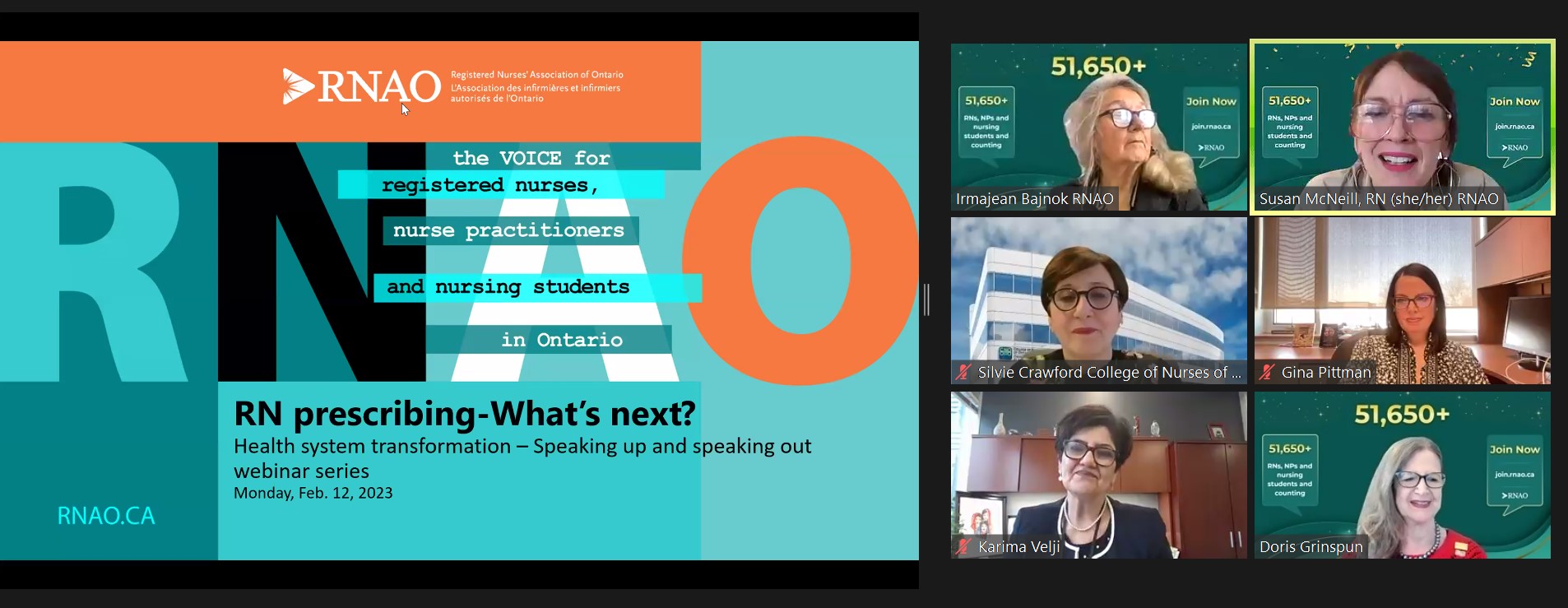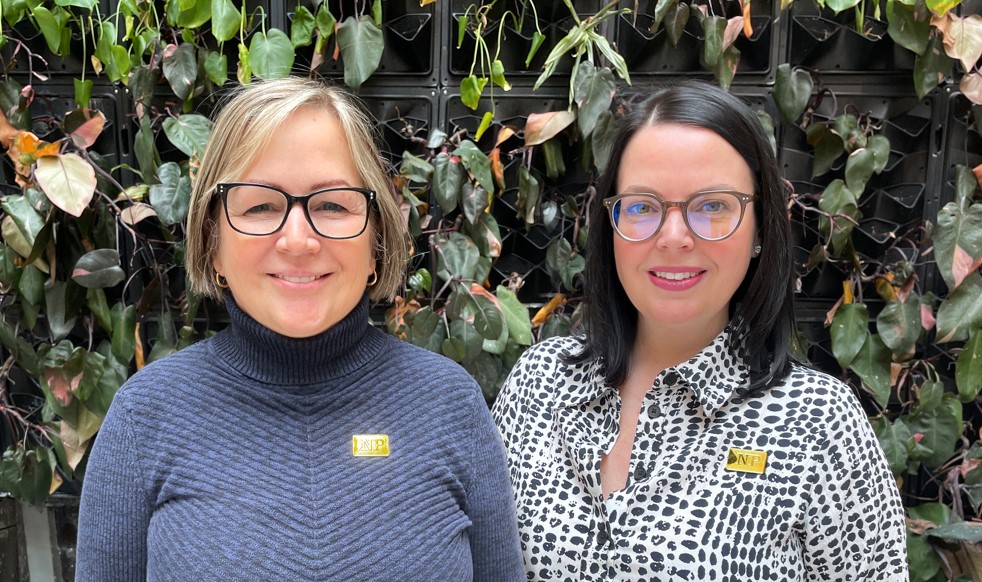
For the past 11 years, RN Arpita Patel has been providing care to students on campus at Toronto’s Humber College. She’s alleviating barriers so they can stay focused on what matters most: their studies. Under a medical directive, Patel and the other RNs in Humber’s health clinic can provide immunizations for the more than 6,000 students enrolled in programs with placements, such as nursing, massage therapy, early childhood education and social support work. Thanks to campus RNs, these students don’t have to see the physicians, unless necessary. Patel says this is just scratching the surface of what’s needed to provide better care.
Currently, the clinic has to turn away students who need travel medication before heading on exchange. Patel also says students looking for a prescription for contraceptives must see a doctor, even though she can perform pap smears. Without a medical directive in place, culinary students with lacerations who require tetanus shots must also get a prescription from the doctor after receiving wound care from the RN.
“If I can do something for somebody without them having an additional appointment with a doctor – which sometimes isn’t readily available – I will do it,” Patel says.
This desire to provide faster access to care became much easier for Patel and her colleagues in November 2023, when the provincial government announced that authorized RNs in Ontario can prescribe travel medications, contraceptives, topical wound care and more (see sidebar for full list). “All of the medications (certified RNs) are allowed to prescribe meet our targets; it’s what we see all the time,” Patel says. RN prescribing will also help free up doctors’ schedules for more complex cases and mental health appointments, which are in high demand among students, she adds.
Despite her excitement about the scope expansion, Patel is not yet enrolled in the optional RN prescribing education program at Humber College because the one session on offer – which started Jan. 22, 2024 – almost immediately reached capacity when registration opened on Dec. 15, 2023. There are currently four different education programs approved by the College of Nurses of Ontario (CNO) and being offered across the province. Patel is holding out for a spot in the program at Humber and says she will enroll once registration opens for the next session.
Faith Guo is an RN at Kingston’s Providence Care Hospital. She jumped on the opportunity to receive prescribing certification as soon as the government announced it in November 2023. Guo enrolled in the University of Windsor’s (U of W) online program and began her studies on Jan. 31. Unlike Patel, the expanded scope will not change Guo’s current practice because under the Public Hospitals Act, RN prescribing is not currently permitted in hospital settings. Guo decided to enroll anyway because: “I always like to have extra education and want to learn the reasons for prescribing in certain situations. It also provides career advancement opportunities.” So far, she is enjoying the course, especially given its flexible format that she can balance with her work and personal life.
NPs Dr. Sherry Morell and Dr. Gina Pittman are co-leading the Ontario University Consortium’s RN prescribing program, which was developed collaboratively by NPs at nine universities and is being delivered by U of W (“the hub”). Morell and Pittman, who both teach in the nursing program at U of W, agreed to take the lead on behalf of the group.
“When we saw (RN prescribing) coming, we knew as NPs the amount of responsibility that comes with prescribing a medication for a patient, and all we could think is what if someone develops a program that isn’t robust?” Pittman shares. “We couldn’t sleep at night knowing people are prescribing when really, they shouldn’t be. So, we said, ‘nope, we’re not going to let that happen.’” Over the course of one week, Morell and Pittman developed the proposed curriculum alongside their consortium colleagues, meeting the CNO’s submission deadline.
Universities and colleges offering the education program teach the RN prescribing competencies set out by CNO, but the way each site chooses to teach, apply and evaluate the competencies can vary. The requirements for entering the program can also differ for each site. To meet CNO’s competencies, the university’s 12-week program consists of virtual modules, quizzes, case studies and a clinical placement at the end. “We wanted (our program) to be almost like how the NPs are taught,” Morell shares. “We felt that it was important that (RNs) learn to diagnose before they prescribe…We go through all the regulations and then we specifically look at what they can prescribe and what do they diagnose for that.”
Given the scope expansion is not met with increased pay and doesn’t currently apply to RNs working in hospitals, Morell and Pittman didn’t anticipate the high response rate they received when enrolment opened for the first sessions beginning in January and March.
What medications can RNs prescribe?
RNs who complete the required training can prescribe the following medications:
Immunization
- Vaccines for the prevention of bacterial and viral disease.
Contraception
- Intravaginal contraceptives and hormonal contraceptives for systemic use (oral and injectable). This does not include intra-uterine devices/contraceptives and contraceptive implants.
Travel health
- Malaria prevention: Aminoquinolines, Biguanides, Methanolquinolines and Doxycycline.
- Traveler’s diarrhea prevention/treatment: Norfloxacin, Ciprofloxacin, Levofloxacin, Azithromycin and Rifaximin.
Topical wound care
- Cracked nipple care: Betamethasone 0.1%, Mupirocin 2% ointment and Miconazole powder to a final concentration of 2%
- Symptom management of odorous wounds: Metronidazole for topical use,
- Any antibiotics for topical use,
Smoking cessation
- Bupropion hydrochloride and Varenicline tartrate,
Anesthetics
- Any anesthetics used topically for pain relief related to immunization and/or topical wound care.
Allergic reaction
- Epinephrine for anaphylaxis.
Over-the-counter medication
- Any drug or substance that may lawfully be purchased or acquired without a prescription and is available for self-selection in a pharmacy.
More information is available on the CNO’s website.
The day after registration opened, 70 nurses had already registered for the first session. In response, the university capped both sessions at 100 and opened a waitlist. “That was before it was even advertised,” Morell emphasizes, adding that it is likely RNs recognize how prescribing will open doors for more career and advocacy opportunities.
U of W hopes to open enrolment once per term for 100 students with fall and winter offerings, but is waiting to hear whether the program will continue to be funded for RNs after March 31, 2024. If it isn’t funded, Morrell says U of W will still offer the program to meet the current demand, but the question of tuition will be up for discussion.
Both Morell and Pittman say RN prescribing will help transform Ontario’s health system by reducing wait times for patients and increasing access to care, especially in primary and community care. More specifically, Pittman sees its potential in remote and rural areas where people have limited access to health care. “I think this will be game changing for those…places.”
RN Caitlyn Cuddy works at De dwa da dehs nye>s Aboriginal Health Centre in Hamilton and is currently enrolled in Georgian College’s RN prescribing course. Cuddy is Métis and a settler from Treaty 3 territory, and provides care to First Nations, Métis and Inuit clients and their family members. She recognizes the many barriers that Indigenous people may face when accessing care, such as trusting health providers, receiving culturally safe care and travelling to appointments. “It’s been an area of passion for me to ensure good access to quality care for people who are underserviced,” Cuddy shares.
In her previous role at a Toronto-based family health team, Cuddy was able to prescribe select medications under a medical directive and became accustomed to a broader scope of practice. That’s why, as soon as RN prescribing was announced, Cuddy said “sign me up.”
Cuddy is anxious to take on more so she can help free up appointments for her NP and physician colleagues, and avoid patients requiring multiple appointments with different providers.
Recently, she answered a triage call from a patient with a vaccine reaction. She knew the over-the-counter medication they needed to treat it, but she couldn’t prescribe it. Instead, she had to call the NP to get a verbal order, “which is an extra step and a task for everyone, and a bit of unnecessary back and forth with the patient.” Once certified, Cuddy says she will be a good “team player” and will take on as much as she can “to help things move smoothly…and have patients be able to access care as they need it.”
In addition to over-the-counter medications, Cuddy says being able to prescribe contraceptives and topical antibiotics to treat wounds – especially on the clinic’s mobile outreach van – will be helpful in her practice. She hopes to see the list of medications expanded to include oral antibiotics to treat uncomplicated urinary tract infections and strep throat, but recognizes that this could take time.
Expanding the medication list down the road is something that may be considered over time. RN Carol Timmings is CNO’s chief quality officer and deputy registrar. She is also an RNAO past-president. She says she anticipates the list of medications to grow over time. For now, the college is monitoring how this initial implementation of RN prescribing goes and how it enhances both the role of RNs and clients’ access to care. “This is a good starting point, but it’s certainly not the end,” Timmings says. “We have every confidence that it’s going to go really well and we like to think about this as the beginning of the journey.” (See sidebar at end for more remarks from CNO).
When developing U of W’s curriculum, Morrell says they considered that the medication list could expand and designed the program with templates in place to allow for additional topics to be covered. “There’s a lot we don’t know right now…but I think CNO is waiting to see what the uptake is and waiting to see how it goes, just like they did with NPs,” Morrell says.
While RNAO also hopes to see the medication list expand, it says the next urgent step is to integrate the educational requirement to prescribe into basic four-year baccalaureate nursing programs. This would allow all RNs to prescribe upon graduation and further open people’s access to care.
“There are 5,000 RNs who graduate each year. With the increase of 2,000 RN seats already rolling out, we will soon see 7,000 RNs graduating each year. Just picture if each will be able to prescribe upon graduation; how it would unlock access and care delays,” RNAO CEO Dr. Doris Grinspun says (read RNAO’s response to the expanded scope, and see the sidebar for more details on RNAO’s advocacy efforts related to RN prescribing).
While she waits to enroll in Humber’s program, Patel is looking ahead at how RN prescribing and an expanded medication list can really help the student population. She says the current medication list meets many needs, but she’d also like for it to include hormone replacement therapy to enhance the clinic’s gender-affirming care practices.
For now, Patel says “this is a good expanded scope to be able to help around the clinic and to help as many students as we can.”
RNAO member becomes first Ontario RN authorized to prescribe
On Feb. 12, 2024, RNAO member Cyril Lee Turley of Northeastern Manitoulin Family Health Team became the first RN in Ontario qualified to prescribe certain medications after completing Georgian College’s online certification program.
“Back in 2017, I heard about this journey that RNAO and the (CNO) and ministry (of health) were taking, and I was working in long-term care at the time and thought it was a perfect fit for my role,” Turley says. Fast forward to 2023, when RN prescribing was announced, and Turley, having moved to primary care, still saw the scope expansion as a great fit for his practice.
The online program at Georgian College is self-paced and features theory-based modules as well as a practical component. Turley says the program was “in depth and well rounded,” leaving him feeling confident to prescribe certain medications for the vast demographic of patients he sees on a daily basis.
In the primary care clinic where he works, Turley is now able to practise more autonomously, resulting in reduced wait times for patients and less paperwork for the clinic’s NPs and physicians. They can attend to more acute and critical-care patients, he says.
“It really allows for positive, quality outcomes for the patients themselves, which is why I think nurses do what we do – it’s all about keeping patients at the centre of their care.”
Turley credits his organization for endorsing the program and giving him (and another RN colleague) time to complete it. “They really have allowed us to start leading this for Manitoulin and I think it’s great they jumped on board with it so quickly,” he says.
RNAO’s monthly Health System Transformation webinar highlights RN prescribing
In February 2024, RNAO hosted a webinar about RN prescribing that attracted an all-time high 1,365 registrants. Participants shared thoughts and questions related to settings where RNs can prescribe, the current academic programs being offered, whether this additional certification allows for independent prescribing, and compensation.
As this expanded scope continues to roll out across Ontario and more RNs become certified to prescribe, RNAO will continue the advocacy it started more than a decade ago to ensure nurses are given every opportunity to provide the kind and quality of care that Ontarians need.
Since 2012, RNAO has advocated for Ontario RNs to be authorized to prescribe medications independently to strengthen access to care and build up the nursing profession. In its June 2012 Primary Solutions for Primary Care report, RNAO outlined recommendations related to RN prescribing with proposed timelines that came and went. In the years that followed, RNAO continued advocating through letters and policy submissions to the ministry of health and College of Nurses of Ontario (CNO), discussions with government, media interviews, and more.
Now that RN prescribing has arrived in Ontario, RNAO is helping RNs understand how it will improve patient care, nursing practice and the province’s health system at large. The February webinar focused on why RN prescribing matters, the scope of it, enablers, barriers and next steps.
RNAO CEO Dr. Doris Grinspun guided the discussion, which featured: Dr. Karima Velji, Ontario's Chief of Nursing and Professional Practice; Silvie Crawford, executive director and CEO of CNO; and Dr. Gina Pittman, assistant professor and co-lead for the university consortium education program on RN prescribing (offered by the University of Windsor).
“We got it, and that’s what matters. Now, let’s make sure it is quickly integrated within the BScN program,” Grinspun said to kick off the discussion. Beginning her remarks, Velji said this expanded scope of practice for authorized RNs “changes the game of health-care delivery for Ontarians and elevates RNs to their true potential in the system.” She also said it aligns with ministry of health priorities, including: expanding education programs for nurses; scope of practice expansion; expediting pathways for international and inter-jurisdictional practitioners; and retention and recruitment of nurses.
During the discussion, Crawford detailed CNO’s RN prescribing standard and resources for nurses to review as this new authority evolves. “This really is a milestone for health sectors and the public,” Crawford said, noting that CNO will continue to engage nurses across the province in this scope expansion and work with health-system partners like RNAO. Participants also had the opportunity to hear from Pittman about the format of the education program and the high degree of interest they’ve received for enrolment. By the end of June 2024, she said 300 RNs will have graduated with authorization to prescribe in several health settings. Other schools that were present at the webinar included Georgian College and St. Lawrence College, whose representatives were acknowledged.
Given the record-breaking interest in the webinar, it’s clear RNs want to learn more. When asked to use one word to describe how RN prescribing makes them feel, participants responded with "empowering," "excited," "opportunity," "finally," and "curious," to name only a few.
RNAO will continue the conversation at its next Health System Transformation webinar on April 22. For more information on this and other upcoming RNAO events, visit RNAO.ca/events.






